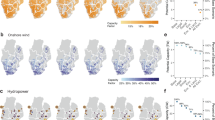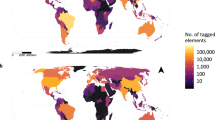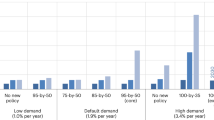Abstract
In the United States, many siting regulations for wind and solar developments are created at the county or township level. Here we survey local zoning ordinances across the contiguous United States to understand the types and frequency of ordinances that might impact wind and solar development. We identify over 1,800 ordinances for wind and more than 800 ordinances for solar in 2022. To understand the impact of ordinances on anticipated land availability, we use spatial modelling on the setbacks specified in the ordinances. Extrapolating the setbacks throughout the country can reduce wind and solar resources by up to 87% and 38%, respectively, depending on the size of the setbacks applied. These results indicate the importance of capturing setback ordinances in resources assessments so as to not overstate resource potential, especially when considering highly decarbonized futures.
This is a preview of subscription content, access via your institution
Access options
Access Nature and 54 other Nature Portfolio journals
Get Nature+, our best-value online-access subscription
$29.99 / 30 days
cancel any time
Subscribe to this journal
Receive 12 digital issues and online access to articles
$119.00 per year
only $9.92 per issue
Buy this article
- Purchase on Springer Link
- Instant access to full article PDF
Prices may be subject to local taxes which are calculated during checkout







Similar content being viewed by others
Data availability
The wind siting ordinance data that support findings of this study are openly available in the Open Energy Data Initiative (OEDI) at https://doi.org/10.25984/1873866. Solar ordinances are also available in OEDI at https://doi.org/10.25984/1873867.
Code availability
Model code used for this submission is available at https://doi.org/10.5281/zenodo.7301491 and https://zenodo.org/record/7473407.
References
Renewable Energy Statistics 2022. IRENA https://www.irena.org/publications/2022/Jul/Renewable-Energy-Statistics-2022 (2022).
World Energy Outlook 2021. IEA https://iea.blob.core.windows.net/assets/4ed140c1-c3f3-4fd9-acae-789a4e14a23c/WorldEnergyOutlook2021.pdf (2021).
Renewable Energy Market Update: Outlook for 2022 and 2023. IEA https://iea.blob.core.windows.net/assets/d6a7300d-7919-4136-b73a-3541c33f8bd7/RenewableEnergyMarketUpdate2022.pdf (2022).
Smil, V. Power Density: A Key to Understanding Energy Sources and Uses (MIT Press, 2015).
Larson, E. et al. Net-Zero America: Potential Pathways, Infrastructure, and Impacts, Final Report 345 (Princeton Univ., 2021).
Denholm, P. et al. Examining Supply-Side Options to Achieve 100% Clean Electricity by 2035 (NREL, 2022).
Hoogwijk, M., de Vries, B. & Turkenburg, W. Assessment of the global and regional geographical, technical and economic potential of onshore wind energy. Energy Econ. 26, 889–919 (2004).
Lopez, A., Roberts, B., Heimiller, D., Blair, N. & Porro, G. US Renewable Energy Technical Potentials: A GIS-Based Analysis (NREL, 2012).
Korfiati, A. et al. Estimation of the global solar energy potential and photovoltaic cost with the use of open data. Int. J. Sustain. Energy Plan. Manag. 9, 17–30 (2016).
van der Horst, D. NIMBY or not? Exploring the relevance of location and the politics of voiced opinions in renewable energy siting controversies. Energy Policy 35, 2705–2714 (2007).
Aidun, H. et al. Opposition to renewable energy facilities in the United States: March 2022 edition. Columbia Law School https://scholarship.law.columbia.edu/sabin_climate_change/186 (2022).
Susskind, L. et al. Sources of opposition to renewable energy projects in the united states. Energy Policy 165, 112922 (2022).
Shum, R. Y. A comparison of land-use requirements in solar-based decarbonization scenarios. Energy Policy 109, 460–462 (2017).
Luderer, G. et al. Environmental co-benefits and adverse side-effects of alternative power sector decarbonization strategies. Nat. Commun. 10, 5229 (2019).
Wu, G. C. et al. Low-impact land use pathways to deep decarbonization of electricity. Environ. Res. Lett. 15, 074044 (2020).
Gerow, J., Gerrard, M. & Dernbach, J. C. Legal pathways to deep decarbonization in the fields of land use and zoning. SSRN https://papers.ssrn.com/abstract=3984255 (2021).
Lerner, M. Local power: understanding the adoption and design of county wind energy regulation. Rev. Policy Res. 39, 120–142 (2022).
Stokes, D. Renewable energy federalism. SSRN https://doi.org/10.2139/ssrn.3810940 (2021).
Frankena, F. Facts, values, and technical expertise in a renewable energy siting dispute. J. Econ. Psychol. 4, 131–147 (1983).
Upham, P. Applying environmental-behaviour concepts to renewable energy siting controversy: reflections on a longitudinal bioenergy case study. Energy Policy 37, 4273–4283 (2009).
Giordono, L. S., Boudet, H. S., Karmazina, A., Taylor, C. L. & Steel, B. S. Opposition ‘overblown’? Community response to wind energy siting in the Western United States. Energy Res. Soc. Sci. 43, 119–131 (2018).
Wiser, R. et al. Land-Based Wind Market Report: 2022 Edition (US Department of Energy, 2022).
Winikoff, J. B. Learning by regulating: the evolution of wind energy zoning laws. J. Law Econ. 65, S223–S262 (2022).
Bolinger, M., Seel, J., Warner, C. & Robson, D. Utility-scale solar, 2022 edition: empirical trends in deployment, technology, cost, performance, PPA pricing, and value in the United States. Berkeley Lab https://eta-publications.lbl.gov/sites/default/files/utility_scale_solar_2022_edition_slides.pdf 10.2172/1888246. (2022).
Lumbreras, S. & Ramos, A. The new challenges to transmission expansion planning. Survey of recent practice and literature review. Electr. Power Syst. Res. 134, 19–29 (2016).
Reed, L. et al. How are we going to build all that clean energy infrastructure? Considering private enterprise, public initiative, and hybrid approaches to the challenge of electricity transmission. Electr. J. 34, 107049 (2021).
You, J. et al. Comparing policy conflict on electricity transmission line sitings. Public Policy Adm. 38, 107–129 (2021).
Mai, T., Lopez, A., Mowers, M. & Lantz, E. Interactions of wind energy project siting, wind resource potential, and the evolution of the U.S. power system. Energy 223, 1–16 (2021).
Bloom, A. et al. The value of increased HVDC capacity between eastern and western U.S. grids: the interconnections seam study. NREL https://www.nrel.gov/docs/fy21osti/76850.pdf (2020).
Brown, P. R. & Botterud, A. The value of inter-regional coordination and transmission in decarbonizing the US electricity system. Joule 5, 115–134 (2020).
Clack, C. T. M. 100% clean by 2050: what does it look like? Vibrant Clean Energy https://vibrantcleanenergy.com/wp-content/uploads/2021/03/VCE-ESIG-03022021.pdf (2021).
Jacobson, M. Z., Delucchi, M. A., Cameron, M. A. & Frew, B. A. Low-cost solution to the grid reliability problem with 100% penetration of intermittent wind, water, and solar for all purposes. Proc. Natl Acad. Sci. USA 112, 15060–15065 (2015).
Stoms, D. M., Dashiell, S. L. & Davis, F. W. Siting solar energy development to minimize biological impacts. Renew. Energy 57, 289–298 (2013).
Kiesecker, J. et al. Renewable energy and land use in India: a vision to facilitate sustainable development. Sustainability 12, 281 (2020).
Lamy, J. V., Jaramillo, P., Azevedo, I. L. & Wiser, R. Should we build wind farms close to load or invest in transmission to access better wind resources in remote areas? A case study in the MISO region. Energy Policy 96, 341–350 (2016).
Hurley, M. Traditional public utility law and the demise of a merchant transmission developer. Northwest. J. Law Soc. Policy 14, 318 (2019).
Wu, G. C. et al. Power of place: land conservation and clean energy pathways for California. The Nature Conservancy https://www.scienceforconservation.org/assets/downloads/Technical_Report_Power_of_Place.pdf (2019).
Rinne, E., Holttinen, H., Kiviluoma, J. & Rissanen, S. Effects of turbine technology and land use on wind power resource potential. Nat. Energy 3, 494–500 (2018).
Aidun, H., Goyal, R., Marsh, K., McKee, N. & Welch, M. Opposition to renewable energy facilities in the United States. Columbia Law School https://climate.law.columbia.edu/sites/default/files/content/RELDI%20report%20updated%209.10.21.pdf (2021).
Maclaurin, G. et al. The Renewable Energy Potential (reV) model: a geospatial platform for technical potential and supply curve modeling. NREL https://www.nrel.gov/docs/fy19osti/73067.pdf (2021).
Buster, G. et al. NREL/reV: PySAM 3 Support. https://doi.org/10.5281/zenodo.7301491 (2022).
Freeman, J. M. et al. System Advisor Model (SAM) General Description (Version 2017.9.5). NREL https://www.nrel.gov/docs/fy18osti/70414.pdf (2018).
Sengupta, M. et al. The National Solar Radiation Data Base (NSRDB). Renew. Sustain. Energy Rev. 89, 51–60 (2018).
2022 Annual Technology Baseline. NREL https://atb.nrel.gov/ (2022).
Protected Areas Database of the United States (PAD-US) 3.0: U.S. Geological Survey data release. USGS https://doi.org/10.5066/P9Q9LQ4B (2022).
National Conservation Easement Database. NCED https://www.conservationeasement.us/ (2022).
Stehly, T. J. & Beiter, P. C. 2018 Cost of Wind Energy Review. NREL https://www.nrel.gov/docs/fy20osti/74598.pdf (2019).
Acknowledgements
The authors thank P. Gilman, Z. Eldridge and J. Botero of the Department of Energy for their thoughtful review and guidance. The authors also thank B. Roberts for developing the maps and D. Heimiller, M. Ruth and D. Bilello of the National Renewable Energy Laboratory for their review and guidance. This work was authored by researchers from the National Renewable Energy Laboratory, operated by Alliance for Sustainable Energy, LLC, for the US Department of Energy under contract no. DE-AC36-08GO28308. Funding was provided by US Department of Energy’s Office of Energy Efficiency and Renewable Energy (EERE) Solar Energy Technologies Office (award number 38421) and Wind Energy Technology Office. The views expressed herein do not necessarily represent the views of the US Department of Energy or the United States Government.
Author information
Authors and Affiliations
Contributions
A. Lopez, W.C. and T.M. conceptualized the study and wrote the article. A. Lopez, P.P., B.S., T.W. and J.G. developed and applied the methods. A. Levine, J.C. and C.M. collected the data. A. Lopez, W.C. and T.M. acquired funding for the study.
Corresponding author
Ethics declarations
Competing interests
The authors declare no competing interests.
Peer review
Peer review information
Nature Energy thanks Yekang Ko, Roberta Nilson and Justin B. Winikoff for their contribution to the peer review of this work.
Additional information
Publisher’s note Springer Nature remains neutral with regard to jurisdictional claims in published maps and institutional affiliations.
Supplementary information
Supplementary Information
Supplementary Tables 1–3, Figs. 1–16, Note 1 and references.
Rights and permissions
About this article
Cite this article
Lopez, A., Cole, W., Sergi, B. et al. Impact of siting ordinances on land availability for wind and solar development. Nat Energy 8, 1034–1043 (2023). https://doi.org/10.1038/s41560-023-01319-3
Received:
Accepted:
Published:
Issue Date:
DOI: https://doi.org/10.1038/s41560-023-01319-3
This article is cited by
-
Artificial intelligence-aided wind plant optimization for nationwide evaluation of land use and economic benefits of wake steering
Nature Energy (2024)
-
Geophysical Constraints on Decarbonized Systems—Building Spatio-Temporal Uncertainties into Future Electricity Grid Planning
Current Sustainable/Renewable Energy Reports (2023)



